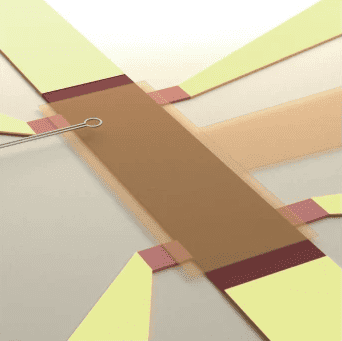Quantum anomalous Hall insulator carries current in its interior, not just its edges
08 Sep 2023 Isabelle Dumé
Where the current flows: Schematic of a SQUID pickup loop imaging stray magnetic fields above a Hall bar sample of dimensions 200 × 75 μm. (Courtesy: Adapted from G M Ferguson et al. Direct visualization of electronic transport in a quantum anomalous Hall insulator. Nat. Mater. 22, 1100–1105 (2023). https://doi.org/10.1038/s41563-023-01622-0)
Insulators are not, by definition, good carriers of electrical current, but researchers in the US have discovered that a special type of insulator known as a quantum anomalous Hall insulator can nevertheless support electrical current within its interior. This surprising result – current was only thought to flow along the edges of such materials – could aid the development of next-generation quantum devices based on so-called topological insulators.
In the ordinary quantum Hall effect, which was discovered in 1980, the interior of a sample becomes an insulator when a strong magnetic field is applied to it. However, an electrical current still flows – in a single direction – along the edges of the sample. This leads to values of the resistance of the sample becoming quantized, or restricted to certain values determined by fundamental physical constants.
The quantum anomalous Hall effect (QAH) is slightly different. Here, the effect arises in a material that is already magnetized, and the material’s resistance is quantized even at even at weak (or indeed zero) magnetic fields. The result is that the current-carrying electrons travel at high speeds along the sample edge without dissipating energy – rather like what happens in a superconductor.
Studying very small currents
In the new work, which is described in Nature Materials, researchers led by physicist Katja Nowack of Cornell University studied a ferromagnetic topological insulator called chromium-doped bismuth antimony telluride. This the material in which the QAH was first observed in 2013. Using high-sensitivity magnetic imaging at very low temperatures, members of the team, which also included researchers at Pennsylvania State University, found that the previous “edge picture” may not be the only explanation for the material’s quantized resistance. Photo of Katja Nowack. Courtesy: Cornell University
Photo of Katja Nowack. Courtesy: Cornell University
 Photo of Katja Nowack. Courtesy: Cornell University
Photo of Katja Nowack. Courtesy: Cornell University“A current generates a magnetic field and it turns out that the current density [within the material] can be reconstructed from an image of one component of this magnetic field,” Nowack explains. “In our experiments, the currents we are studying are very small, below 25 nA, and we needed to go to temperatures as low as around 25 mK to observe a robust QAH. Our probe’s sensitivity and our ability to reach the necessary temperatures allowed us to do a good experiment.”
A fundamental shortfall in understanding
These sensitive measurements revealed that electrons flow within the bulk of the material, not at the boundary edges as expected. According to Nowack, this result could re-open the debate on how current flows in ordinary quantum Hall insulators, as when they were discovered, it was unclear where current actually flowed.READ MORE

“It’s clear that we don’t even understand some very fundamental aspects of what happens in topological materials,” she says. “Electron behaviour in a material is a very fundamental property and deepening our understanding of how electrons behave in quantum anomalous Hall insulators and in the wider range of topological materials touches on foundational scientific questions as well as being important for developing useful devices based on these materials.”
The next question, she tells Physics World, is to find out how general the team’s findings are. “We have imaged just a few devices from this material class, but a beautiful aspect of quantum anomalous Hall insulators is that many different local current distributions can give rise to the quantization that is observed in a transport measurement,” she says. “Thus, I’m curious to study more of these insulators to learn if the current flows in the same way or differently.”

Isabelle Dumé is a contributing editor to Physics World
FROM PHYSICSWORLD.COM 9/9/2023

Δεν υπάρχουν σχόλια:
Δημοσίευση σχολίου